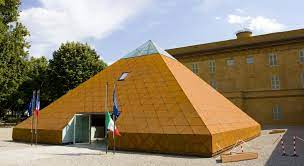The Napoleonic army waded the river Tagliamento and removed the Habsburg troops at the Battle of Valvasone (16 March 1797): the triumph opened the stay of Napoleon at Villa Manin, the sixteenth-century residence of the last Doge of Venice, in Passariano di Codroipo. Here the Little Corporal knew General Louis Desaix (Ayat-sur-Sioule, 17 August 1768 – SpinettaMarengo, 14 June 1800), commander of division at the Battle of the Pyramids (21 July 1798). The large divisional square, the military technique promoted by the General, neutralized the Mamluk cavalry (75 thousand units) of Ibrahim and Murad Bey (governor of Egypt, elected by the Ottoman Sultan): the French army (25 thousand men) – so arranged, to defend the horseback militia and artillerymen – eliminated the most pernicious enemy on the battlefield. The team of 165 scientists (Savants) linked to the Egyptian Campaign, designed to strike the British hegemony over the Mediterranean Sea, extended the Middle Eastern culture to the world. “Je tiens l’affaire!”: the sentence dated 14 September 1822 exalts the enthusiasm of Jean-François Champollion (Figeac, 23 December 1790 – Paris, 4 March 1832). The French Egyptologist solved the riddle to reveal the Egyptian language from the inscription engraved on the black granite stele found in Rosetta (15 July 1799). The stone, which has been in the British Museum in London since 1802, was also present in the Alexandrian capital, founded by the conqueror Alexander the Great: the coastal city is the seat of the new Bibliotheca Alexandrina, the center of primary erudition in the Mediterranean Basin, operative since 16 October 2002, to celebrate the Royal Library, the richest Hellenistic cultural jewel destroyed from 48 B.C. to 642 A.D. Napoleon, seduced by the boundless empire built by the Macedonian leader, united imitation Alexandri to his chosen lifestyle.
The epic story transfers the symbolic force from Africa to Europe and the homonymy strengthens the liaison and reduces the geographical distance. Civitas Nova, promoted by Bishop Galdinoof Milan and also financed by the Municipality of Genoa to open the commercial route to the centre of the Po plain, was donated to Pope Alexander III and, therefore, renamed Alessandria (3 May 1168). The city has changed on the epilogue of the battle won at Marengo (14 June 1800) by the French militias led by Desaix and Kellermann. Alexandria was elected a military and strategic stronghold for the whole northern Italy: the cathedral of San Pietro was demolished to build the square of arms, adjacent to the Palazzo Ghilini, renamed Imperial Palace thanks to three stays of Napoleon. The emperor explored the modernized fortifications of the city and the civil and military organizational structure of the newborn Department of Marengo, acquired by France, and descended from the nodal victory. That battle was also resumed by the first modern historical re-enactment: this pearl of living history set up on the wooded plateau of Fraschéta (Sunday, 5 May 1805) delighted the Little Corporal – wrapped by uniform and cocked hat, that he wore five years earlier – and his bride Joséphine, both headed to Milan for the coronation of Napoleon to King of Italy (26 May 1805). Here the General placed in the ditch the plate with the engraving “Napoleon Emperor of the French and King of Italy to the defenders of the homeland who died on the day of Marengo” that is the first stone of the pyramid, erectedto guard the eternal memory of the generous souls fallen to Marengo. The imperial decree entrusted the military genius with the order to build the mausoleum with a hall equipped with marble tables carved by the name of every man who died that glorious day. The sovereign edict, disregarded by the unfinished work, was revered by the more modest pyramidal structure, opened since 2009, near the Marengo Museum set up at Villa Delavo.
